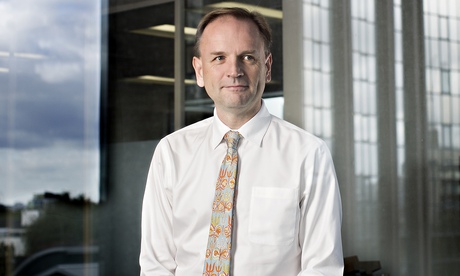From his offices, with their panoramic views of south London, Simon
Stevens can see the scene of his happiest experience with the NHS so far
– St Thomas’ hospital, where his wife, Maggie, gave birth to their son
in 2003. “Because it was Christmas day, a lot of staff were off and
there were locums. There was a bit of Christmas spirit, but a lot of
planned deliveries not happening, so when my son was born they basically
said, ‘If you and your wife want to go to an empty ward, you can spend
the night there with your baby.’ In this darkened ward with no staff we
spent a very happy first night.” The recollection prompts a smile.
He can also recall his worst moment. He was just seven. “I had a hip problem and was in hospital for the best part of a school term. It is a visceral memory. I woke one morning and I couldn’t walk. I crawled to my parents’ bedroom. They took a bit of persuading that I wasn’t just messing about, but we went to hospital. I still remember when the staff said to them, ‘OK, you can leave him now.’ That first night. I was just screaming: that complete sense of abandonment.”
It is Stevens’ blessing and his curse that everyone has a story about the NHS. Good accounts still outweigh the bad, but with funding at its tightest ever, waiting times deteriorating sharply, and GP waiting rooms and hospitals full to the rafters, how long will that be so?
This week, six months into his new job and amid much ballyhoo, Stevens unveiled the Five Year Forward View – his long-awaited blueprint for revolution in the NHS at a time of unprecedented pressure and hitherto unseen austerity. With the #NHS ailing, many question its future – can it keep up with an ageing population, ever higher expectations, ever harsher scrutiny? Stevens, 48, affable, chatty and sharp as a tack, thinks it can. He has come to save it.
And he has come a long way – 4,000 miles, to be precise, from the north-eastern US state of Minnesota, where he worked for nine years at United Health, the world’s largest private health company; as vice-president, he was responsible for its activities (some private, some both public and private) in the US, Europe and South America. Before that, however, he spent a much longer time in the NHS: he joined as a graduate management trainee in 1988, going on to run hospitals, community hospitals and psychiatric units, and later advising two Labour health secretaries, Frank Dobson and Alan Milburn, and then Tony Blair. But his track record at No 10, and especially within the commercialised #US health system, raises suspicions and hackles. When he was hired, the Health Service Journal, assessing his task and noting his capabilities, said he has the chance to be “one of the most important figures in the history of the NHS”. At the same time, Dr Richard Taylor, the former hospital consultant and former independent MP – now co-leader of the National Health Action party and fiercely anti-privatisation – called his ascension “the nail in the coffin” of the NHS.
Stevens laughs that off. “I decided this was an important moment for the NHS, something I care very deeply about,” he says. “I asked myself two questions: can the NHS make it, and is the job I am considering doable? I concluded yes to both.”
He has seen it at its most challenged, and at its most communal. “I started in Consett, County Durham. I lived in Consett and worked at the hospital – I went back there on my first day in this job on 1 April. It is a wonderful place, but [when I started] the steelworks had recently closed and the hospital was the biggest employer. There were interesting social changes on the back of that; ex-steelworkers were taking what was previously regarded as women’s work in the laundry.” He shared a flat with two junior doctors and the women who ran the laundry. They spent lots of time in the pub, part of a very tight community. “If you wanted an example of an NHS of the people, by the people, for the people, that is what you absolutely had in Consett.” Carless then, he travelled around by bus. “There was a lot of poverty and industrial-related illness; people with chronic lung problems, communities in some sense bypassed by the economic dislocations of the 1980s.” He carries the images, remembers the people.
